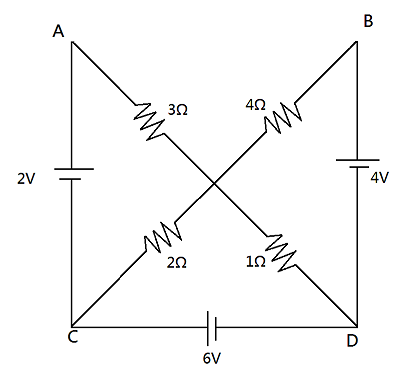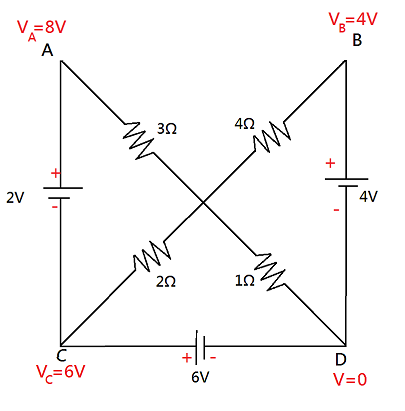
The potential difference between the point A and B is:

A) $5\,V$
B) $4\,V$
C) $3\,V$
D) $2\,V$

Answer
557.4k+ views
Hint: Consider the potential at any one of the four points to be zero. Accordingly, there will be potential drop or potential gain as we move towards another point through the battery. With the assumed point find the potentials at all other points and thus the potential at A and B can be found. Then we can simply find the difference between the potentials of A and B.
Complete step by step solution:
There is a battery connected between two points. The battery will create the potential difference across the points equal to the potential of the battery. Thus, we can assume the potential at some point to be zero and accordingly calculate the potential across the adjacent battery.
Let the potential at point D be zero. Consider the following diagram:

We have considered the potential at point D to be zero. There is a battery of $4V$ between point D and B thus, there must be a potential difference of $4V$ between point D and B. As point D is at zero potential thus, point B must be at $4V$ potential.
Similarly, point C ${V_C}$ will be at ${V_{C = }}6V$ .
Now, there is a battery of $2V$ between points C and A. So, there must be potential difference between points C and A. Thus, the potential at point A can be of $4V$ or $8V$ . But we know that when we are moving from negative terminal of battery towards positive terminal there is gain in potential therefore, there must be a gain of $2V$ when moving from point C towards point A.
As a result, the potential at point A will be ${V_A} = 8V$ and potential at point B ${V_B}$ is ${V_B} = 4V$
The potential difference between point A and B will be:
$\Rightarrow$ ${V_A} - {V_B} = 8V - 4V = 4V$
The potential difference between the points A and B is $4V$.
Therefore, option B is the correct option.
Note: When we move from negative terminal to positive terminal of the battery there is a gain in potential. As the battery provides a potential difference between two points therefore, we can consider the potential at any point to be zero and accordingly calculate the potential at other points.
Complete step by step solution:
There is a battery connected between two points. The battery will create the potential difference across the points equal to the potential of the battery. Thus, we can assume the potential at some point to be zero and accordingly calculate the potential across the adjacent battery.
Let the potential at point D be zero. Consider the following diagram:

We have considered the potential at point D to be zero. There is a battery of $4V$ between point D and B thus, there must be a potential difference of $4V$ between point D and B. As point D is at zero potential thus, point B must be at $4V$ potential.
Similarly, point C ${V_C}$ will be at ${V_{C = }}6V$ .
Now, there is a battery of $2V$ between points C and A. So, there must be potential difference between points C and A. Thus, the potential at point A can be of $4V$ or $8V$ . But we know that when we are moving from negative terminal of battery towards positive terminal there is gain in potential therefore, there must be a gain of $2V$ when moving from point C towards point A.
As a result, the potential at point A will be ${V_A} = 8V$ and potential at point B ${V_B}$ is ${V_B} = 4V$
The potential difference between point A and B will be:
$\Rightarrow$ ${V_A} - {V_B} = 8V - 4V = 4V$
The potential difference between the points A and B is $4V$.
Therefore, option B is the correct option.
Note: When we move from negative terminal to positive terminal of the battery there is a gain in potential. As the battery provides a potential difference between two points therefore, we can consider the potential at any point to be zero and accordingly calculate the potential at other points.
Recently Updated Pages
A man running at a speed 5 ms is viewed in the side class 12 physics CBSE

The number of solutions in x in 02pi for which sqrt class 12 maths CBSE

State and explain Hardy Weinbergs Principle class 12 biology CBSE

Write any two methods of preparation of phenol Give class 12 chemistry CBSE

Which of the following statements is wrong a Amnion class 12 biology CBSE

Differentiate between action potential and resting class 12 biology CBSE

Trending doubts
What are the major means of transport Explain each class 12 social science CBSE

Which are the Top 10 Largest Countries of the World?

Draw a labelled sketch of the human eye class 12 physics CBSE

Explain sex determination in humans with line diag class 12 biology CBSE

Explain sex determination in humans with the help of class 12 biology CBSE

Differentiate between homogeneous and heterogeneous class 12 chemistry CBSE




